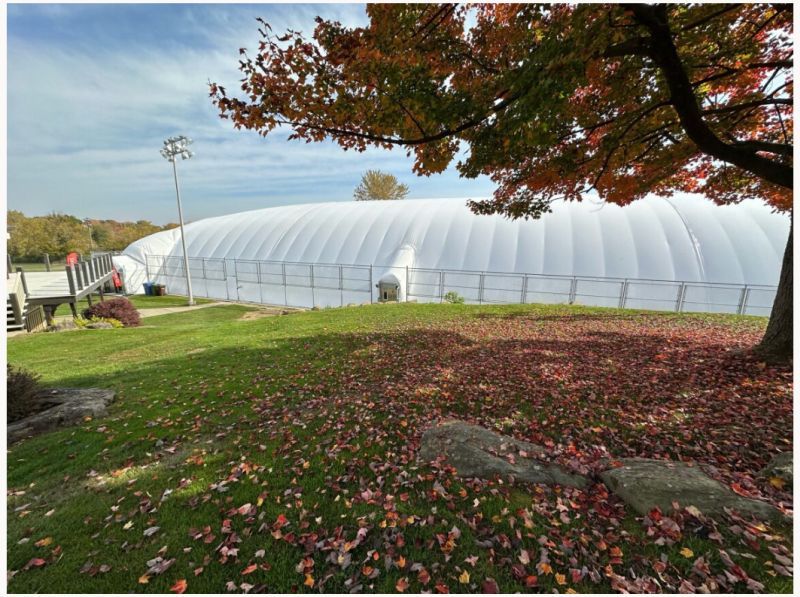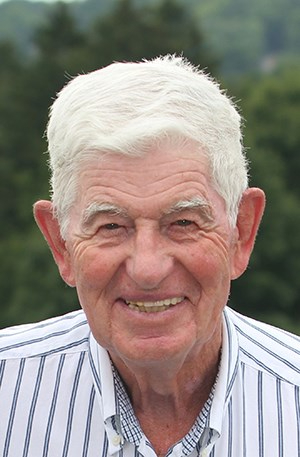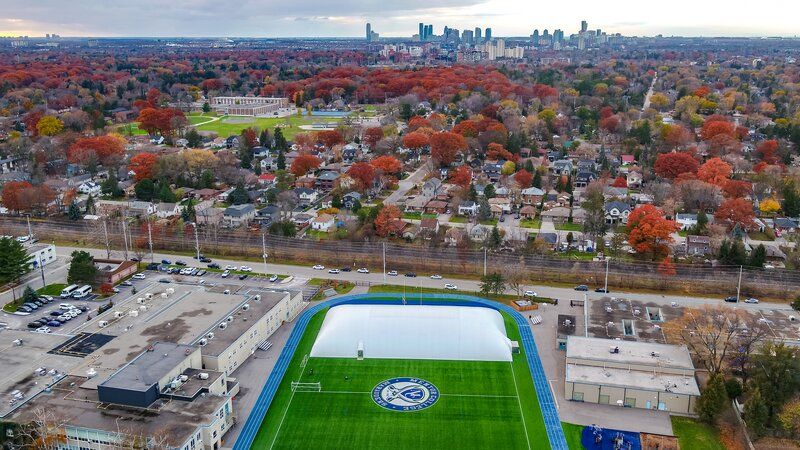
We collect basic website visitor information on this website and store it in cookies. We also utilize Google Analytics to track page view information to assist us in improving our website.

How many times have you frantically checked (and re-checked) the forecast before a game, hoping the rain would hold off or the heatwave would break?
Today, managing outdoor sports is becoming more and more like predicting the weather: a tricky and often unreliable task.
Climate change is forcing society to adapt, and sports are no exception. It’s time to talk about solutions.
Here’s why air-supported domes, like those from The Farley Group, can keep the game going even with extreme, unpredictable weather conditions.
As climate chaos becomes the new norm, sports leagues and businesses worldwide are grappling with the consequences. The rules of the game are evolving and bringing new challenges with them.
Take tennis, for instance. The sport demands prolonged exposure to scorching courts, leaving players vulnerable to heat-related illnesses as temperatures soar. The sweltering heat radiating off hard surfaces only compounds the issue, risking not just the well-being of players but also that of ball boys and girls and spectators.
With over 80% of tennis tournaments staged outdoors, sometimes with matches that stretch for hours, extreme heat poses an existential threat. Recognizing this danger, the US Open has implemented an extreme heat policy, allowing for breaks and match suspensions during temperature spikes.
Soccer has also felt the heat. You’ll remember that the 2022 FIFA World Cup in Qatar was rescheduled from its traditional June-July slot to November-December to avoid scorching summer temperatures that could jeopardize players and fans alike. It’d be nice to think that was just a Qatar problem, but it wasn't—local and multinational organizations alike, from Major League Soccer (MLS) to Alberta Soccer in Canada, have also had to set new safety thresholds to deal with hot weather events and pollution peaks.
Speaking of pollution, we can’t forget how many of us have had to cancel games because of the poor air quality caused by record-breaking wildfires across many parts of Canada and the United States. The shifting climate is a major contributor to wildfires being as bad (and as frequent) as they are.
The bottom line is that increasingly frequent extreme weather events are becoming the norm.
An analysis by Climate Central revealed a concerning trend: 198 US cities have experienced a surge in days with heat index temperatures of 90°F or higher over the past four decades.
Extremely rainy days have also become 18% more common since pre-industrial times, with projections indicating a potential 65% increase if global warming hits 2°C.
It’s not good news for those of us who are invested—not only financially, but as a way of life—in outdoor sports. And it demands a massive, strategic overhaul in how sports facilities are planned and managed.
What if you could take climate uncertainty out of the equation?
Imagine not having to cancel another game or reschedule an event because of weather woes.
This isn't just wishful thinking. With the right kind of setup, it's possible.
An air-supported dome is like a trusty umbrella that never fails. Here’s how our Farley domes (often called “bubbles” in the case of tennis domes) are safe spots for sports no matter what the sky throws down.
Imagine a giant, inflatable bubble that you can play sports inside. That's pretty much what Farley domes are, but with some extra tough skin.
Made from layers of strong, UV-resistant fabric, our domes can stand up to heavy winds, beating rain, extreme heat, and loads of snow without as much as a flinch. They're held down by heavy cables and a solid anchoring system that makes sure the dome stays put, even on super windy days. Rain or shine, the games go on.
The best part? Inside the dome, there are no poles or beams in the way, so you’ve got all the space you need to kick, run, or swing without bumping into anything. It’s a completely clear-span structure.
Inside of a dome, the temperature and humidity are always just right. Thanks to advanced climate control systems, the temperature and humidity inside our domes are maintained at optimal levels for athletic performance and spectator comfort.
On a hot, humid day, the air inside the dome is cool and fresh, creating a comfy oasis from the sweltering heat. During colder months, the dome is warm and inviting, shielding you from the biting cold outside.
We know athletes perform at their best when conditions are consistent. The controlled climate reduces the risk of heat-related stress and cold-induced injuries so that players can focus on the game without worrying about the weather. This consistent and comfortable environment is also better for spectators (soccer parents, that means you!)
For private clubs and businesses, the promise of a pleasant playing experience is also a massive competitive advantage. People are more likely to join (and actually attend) when they know they'll be playing in comfort, regardless of the weather conditions outside. This reliability can help you maintain and even grow your member base, increase rentals, and improve event participation.
Our domes have a smart ventilation system that keeps the air fresh and the temperature steady. Whether it's a hot, sticky day or a cool evening, the air inside the dome is just perfect for sports, ensuring that athletes and fans are comfortable, and the game is always on.
Seasonal domes are installed over outdoor courts or fields temporarily, usually in the fall or winter, and then taken down when the weather is favourable. Permanent domes, on the other hand, stay put all year long.
For clubs, municipalities, and academic institutions looking to weatherproof their outdoor spaces without sacrificing sunny days on the field, a seasonal dome is a practical, flexible solution.
Traditionally, most facilities with a seasonal dome would put it up in the fall and take down the dome come spring. This allows sports like soccer and tennis to continue indoors during the colder months, then resume outdoor play in the spring.
But if the weather is particularly unforgiving one year—say, you’re deluged with buckets of spring showers just won’t end—you can leave the dome up well into the summer.
However, if you’re faced with a sweltering summer, you can put up the dome in the middle of the summer to give players relief.
The point is, with a seasonal dome, you don’t have to ‘commit’ to converting outdoor facilities to indoor ones. You have the freedom to decide for yourself when it’s time to change course.
Of course, for areas or sports that require year-round consistency, permanent domes are the answer. These structures remain up all year, providing a consistent venue that doesn't depend on the weather.
Debating between a permanent dome and a seasonal dome? Get in touch. We’ll help you figure out which kind of dome is right for you.
There’s no denying that climate is changing the way we plan and play outdoor sports. From extreme heat and poor air quality to unexpected rainfalls and cold snaps, the challenges are real, and they're here now.
But these challenges don't have to mean game over for your sports events.
Air-supported domes offer a robust, smart solution that keeps the weather out and the games going.
Domes not only protect against rain, sun, snow, and pollution at only a small fraction of the cost of traditional, brick-and-mortar indoor sports facilities. They're quick to install over existing fields and courts, providing an affordable way to transform outdoor venues into year-round facilities. And with powerful air exchange systems, Farley domes provide a controlled, healthy environment that lets athletes perform at their best and spectators relax, no matter the season.
We encourage you to explore more about how The Farley Group’s domes can benefit your sports programs and events. Whether you're looking to upgrade existing facilities or build new ones, consider how a Farley dome could be your next game-winning strategy. Contact us to find out how you can turn your sports venue into a weatherproof, year-round destination for athletes and fans alike.
A traditional summer sport is becoming a big smash this winter.
Watch how The Farley Group is revolutionizing indoor tennis in Quebec, with our latest dome featured on Global News. Learn about the incredible impact of our inflatable tennis domes, and how our air supported structures are keeping the spirit of the game alive even in the chill of winter.
Former top ranked Canadian tennis player Francois Godbout discusses his contribution and enthusiasm for the game, embracing these innovative spaces sanctioned by Tennis Canada.
It's not just a game—it's our passion to provide cutting-edge facilities that bring communities together. Watch the video to see The Farley Group's commitment to sports and leisure in action.

PUSLINCH, ONTARIO, CANADA, February 8, 2024 - It is with deep sadness that The Farley Group announces the passing of our founder, Ralph Farley, on December 16, 2023. He passed away peacefully at Hospice Wellington, just a month shy of his 93rd birthday.
Ralph Farley was regarded as a pioneer in the world of air-supported domes. He was credited as the first to introduce this technology to Canada, New Zealand, China, and Russia. He founded The Farley Group, which has since become a global leader in the industry. Under his guidance, The Farley Group had a hand in over 900 domes worldwide, primarily focused on North America, transforming the landscape of indoor sports and multi-sport facilities.
Ralph Farley's legacy reaches beyond his business achievements. He was known for his warm personality and cherished the friendships he developed throughout his career, many of which spanned decades. His passion and dedication were an inspiration to all who knew him.
The Farley Group extends our deepest sympathies to Ralph’s wife, Sheila, his family, and all who were touched by his remarkable life. As we mourn the loss of a great leader and friend, we also celebrate the enduring legacy he leaves behind.
Lauren Trevor, President and CEO of The Farley Group, remembers Ralph fondly, saying, “I will always remember Ralph’s warm smile in the office every morning when I first started with the company 6 years ago. Even at the age of 87, he would walk down the hall several times a week to my office, asking to borrow my paper shredder, insisting on doing it himself. His presence was a blessing to us all, especially at John’s Retirement/25th Anniversary gathering in August. He will be deeply missed.”
In lieu of flowers, Ralph Farley’s family asks that those who wish to commemorate him please make a donation to Hospice Wellington in his memory.
About The Farley Group
The Farley Group has a proud 50-year tradition in the manufacturing, installation, and servicing of sports domes throughout the world. Since its founder, Ralph Farley, brought the concept to North America from Sweden over 50 years ago, Ralph and his associates have been committed to quality and integrity in dome design and fabrication. Today, The Farley Group is made up of expert staff of sales consultants, designers, and highly skilled production and service professionals experienced in all facets of air structure technology. The Farley Group is committed to providing only the best products and ensuring their customer experience is the best in the industry.
Samantha Donaldson-Scharf
The Farley Group

As the weather turns colder and the days shorter, sports lovers grapple with unpredictable weather conditions. The transition from fall to winter can be challenging, not just for athletes and coaches, but also for facility owners, as it impacts the continuity of all kinds of outdoor sports: soccer, tennis, golf, track and field, and other field sports.
However, there's a practical solution to this dilemma: air-supported domes. These domes are a game-changer for seasonal sports. They extend the momentum of summer activities into the fall and seamlessly carry it through the winter's chill.
Under a Farley Dome, athletes can train and compete in comfortable, consistent conditions, regardless of the weather outside. Essentially, domes bridge the gap between fall and winter sports, turning a once challenging period into a seamless, year-round sports experience.
In this blog post, we will talk about the many ways that air-supported domes not only benefit facility operators but also athletes and the broader sports community during the fall-to-winter transition.
The Farley Group has been manufacturing, installing, and servicing sports domes around the world for more than 50 years. Ever since our founder, Ralph Farley, introduced air-supported domes to North America, The Farley Group has led the industry with our commitment to quality and integrity. Our team consists of sales consultants, designers, and highly skilled production and service professionals skilled in all aspects of air structure technology. We’d love to talk to you about your dome project.
Call us or send us a message to get started now!
In Canada and the States, where the weather shifts from mild to harsh unpredictably, transitioning between seasons poses a significant challenge for sports continuity. Sports popular in the summer months often come to a halt in the winter, especially in communities lacking affordable indoor sports facilities.
Warm-weather sports like soccer, tennis, and golf really feel the impact when seasons change. Air-supported domes, however, make transitioning from fall to winter in these sports effortlessly smooth.
The excitement of a soccer game on a crisp fall day can quickly diminish with unpredictable weather. Rain, snow, and cold not only dampen spirits but also disrupt schedules, rendering fields unusable and hazardous. What were once lush, green fields become muddy or icy, increasing injury risks and diminishing the quality of play.
Plus, shorter days limit practice and game time, forcing players and coaches to squeeze in activities before nightfall.
Example: Afrim's Sports is the place to be when it comes to indoor soccer in the Albany, New York area! Located at the home of the Bethlehem Soccer Club, this Farley Dome covers nearly 44,000 square feet of indoor turf.
Tennis courts also suffer from seasonal changes. Damage from moisture, cold, and freeze-thaw cycles compromises playing surfaces, making them unsafe and hindering the play experience.
Cold temperatures also affect players and their equipment, with every drop in temperature impacting comfort and performance.
Without indoor alternatives, players lose valuable practice time essential for skill development and competitive edge.
Example: Barrie North Winter Tennis, a division of Tennis Clubs of Canada, is located in Midhurst, Ontario, and consists of 4 tennis courts under a heated, air-supported Farley dome complete with new LED lighting. The Farley Dome is erected in early October, and is taken down at the end of April each year.
Golfers face challenges as driving ranges become less inviting in colder, wetter conditions.
Practicing swings and techniques is harder, and golf gear, like balls, performs differently in the cold, affecting gameplay. This drop in comfort and accessibility leads to reduced player turnout.
Example: The Hastings Fieldhouse Farley Dome features a walking track, soccer field, golf driving range, as well as courts for basketball, ball hockey, and racquet sports. It truly is a multi-functional facility. It includes the capacity to accommodate many varied and unique training activities, as well as clinics and workshops.
Winter poses major challenges for track and field athletes. Outdoor tracks, essential for training, become unusable due to snow and ice. Each event, with its specific training requirements, is disrupted, affecting preparation and performance.
The cold weather also increases the risk of muscle strains and injuries, as proper warm-up becomes more difficult and slippery conditions pose additional hazards.
Example: The Farley Dome at University of Alberta's Foote Field is the largest, air-supported dome structure in all of Alberta, turning the seasonal field into a year-long training facility. It includes a multi-lane, 140 meter track with a jump pit available to the track and field community of Edmonton.
Each year, facility owners and operators face the challenging transition from fall to winter sports. This is where air-supported domes, particularly Farley Domes, come into play. Our domes are designed to help make manging sports facilities straightforward and efficient, regardless of the season.
One of the standout features of our domes is their rapid setup. They can be erected in just a day or two, minimizing downtime and keeping the sports schedule on track. This speed is a lifesaver for places that need to switch from open-air to indoor settings quickly when the weather changes.
Timing is everything here. Facility owners can time the dome set-up right at the end of the fall season. This means no awkward gaps — just smooth sailing from outdoor to indoor sports. It's this kind of scheduling smarts that helps get the most out of facilities all year round.
The ability to control the climate inside these domes is a significant advantage. Owners can dial in the perfect temperature, making it comfy for both players and fans. This matters a lot when you're moving from the mild fall to the chilly winter.
Stable conditions are key for sports where the weather really affects the game. Domes keep things consistent, offering the best setting for sports, come rain or shine.
Energy efficiency is another big plus. These domes use smart heating and cooling, keeping costs down, especially in the colder months when heating bills can go through the roof.
Domes are champs at handling sudden weather shifts. They can warm up or cool down in no time, crucial for dealing with those unpredictable fall and early winter days. This means the facility stays open and comfy, no matter what Mother Nature throws at it.
These domes also extend playtime. As days get shorter and colder, indoor domes offer a bright, warm spot for evening and night games.
And let's not forget how well they protect against the elements. Wind, rain, snow — domes keep them all out. This means less weather delays and more reliable schedules for teams and facility owners.
With their quick setup, climate control, and weather readiness, they're the perfect choice for facility owners wanting to keep the game going all year long. Choosing a dome isn't just prepping for winter; it's opting for non-stop sports, no matter the season.
For sports facility managers wrestling with tough decisions, choosing air-supported domes is a no-brainer. It's a move toward keeping the action going and growing. Think of it as an investment that pays off in more ways than one!
Why let the weather dictate another season? Now's the chance to turn your sports facility into a year-round hub of excitement.
As we gear up for winter here at The Farley Group, we're thrilled to share a feature from New York Tennis Magazine that showcases what we do best: helping keep tennis alive during the colder months!
Our CEO, Lauren Trevor, chatted with New York Tennis Magazine about our approach to designing, building, and helping maintain the world’s best tennis domes, including dozens in and around New York City. We're especially proud of our work in the Big Apple, where we've had the opportunity to tackle some really unique challenges—including building tennis domes on top of parking structures and beneath the Queensboro Bridge.
A big thanks to New York Tennis Magazine for the spotlight! To get the full story on our role in the tennis world, check out the full article here.
[Read Beyond the Baseline: Lauren Trevor, The Farley Group]
